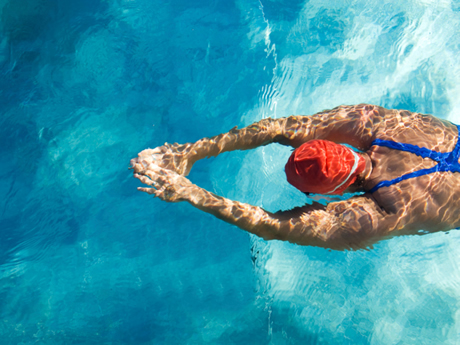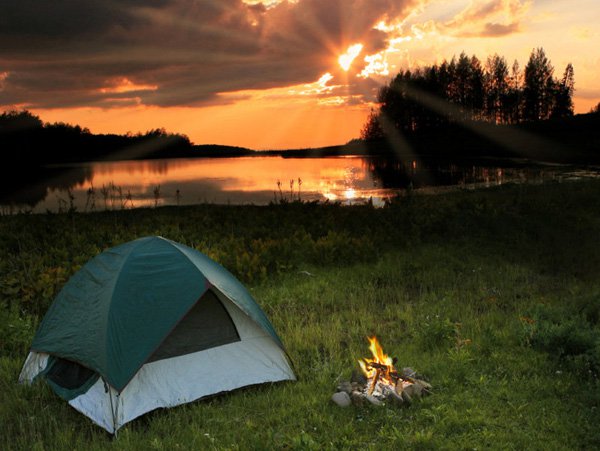Bass fishermen can get locked into a routine that might be self-defeating. At the beginning of a fishing trip, they rig up the lures that worked for them before on a particular lake and at a certain time of the year. They pick through soft-plastic baits to find the "hot colors" for the month, or choose the crankbaits that really caught 'em here last year. In other words, some anglers automatically do what they did before, without
taking into account environmental changes that could alter the fishing
picture. And perhaps no factor is more overlooked than water clarity.
Water clarity determines how well and how far bass can see. It can change many times over a day's fishing. A lake can be very clear in general but turn muddy where a stream pours into it. And muddy lakes can contain patches of clear water where springs well up from the bottom, or where they're fed by clear creeks.
Early and late in the day visibility in a dingy lake is low, but the middle of
a sunny day will enhance visibility, allowing bass to see farther. Water clarity is never a permanent state, and observing it and anticipating changes when you are on the water will help you determine success. It is not the only factor, because bass rely on their other senses to survive, but water
clarity is important.
So, how do we measure visibility below the surface, and how do we fish murky and clear waters? The old-
fashioned test is to tie a bright yellow or white lure to your line on a 6-foot rod and then extend the rod into the water. If you can see the lure, the water is clear and you can bet bass will see your lures from several yards away.
If the lure disappears at 3 to 4 feet, the water is dingy but you're still in good shape, especially if you will be fishing shoreline cover. If the lure isn't visible beyond a foot away from the surface, the water is murky. And if it
is not distinguishable at inches, then you've got muddy water and will have to employ special tactics to attract bass.
Bass can be caught from water where visibility is at either end of
the spectrum. But different conditions require different approaches. The following tips will help you formulate a master plan to match the circumstances you encounter.
Downsized and Sneaky
Keep in mind that all fish, regardless of their size, are spooky in clear water. If you're going to fish water that's so clear you could read a newspaper on the bottom from 10 feet away, be prepared to make long casts well beyond visible targets. Not only do bass become skittish at the sight of an approaching angler, but they also race for the depths when they hear a fisherman approach.
Use your boat's trolling motor sparingly, if at all; drifting is better if you have a favorable wind. The first place to look for bass is near any available cover, especially on bright days. Baitfish hide in heavier cover such as flooded treetops or bushes, in aquatic weed beds or underneath docks; fish cover thoroughly because bass gravitate to such sanctuaries to pounce on any prey that are foolish enough to leave their hideaways. Use the lightest low-visibility line your tackle will accommodate. Fluorocarbon monofilament will do the job nicely. [pagebreak]
Choose lure patterns that resemble the size and shape of the predominant food fish, like shad or shiners. Try small crankbalts-lipless or billed-that can be retrieved rapidly and have a tight wobble. Don't rule out buzzbaits, either. If you want to try a topwater lure, pick a stickbait that can be worked across the surface quickly. Subtlety is the key here. Sometimes you don't want bass to get a good look at a lure; you just want to trick it into thinking the bait is a free lunch that
is running away and entice the fish into a reaction strike.
Some days bass won't chase down a lure, regardless of water clarity. Rather, they want their meals served up in front of their noses.
If a fast retrieve doesn't work, switch to small Texas-rigged plastic worms in neutral colors such as natural, red or black. Straight-tail worms will work best in these circumstances. The Charlie Brewer Slider rig, which
features a worm or other small soft-plastic lure Texas-rigged on a weighted head, is a good choice. A drop-shot rig is another excellent way to present baits to reluctant fish. It can be fished in place with the barest movement imparted by the rod tip.
Use the most natural looking baits you can find, in subdued colors. Stick with the cover, or fish near drop-offs where light penetration is diminished and fish feel more secure.
Dingy Water Isn't So Bad
South of the northern lakes made gin-clear by the filtering work of zebra mussels, most of us fish slightly turbid water around the calendar. That's okay, because it provides us with the greatest range of possibilities. For one thing, bass aren't so skittish and you can use rigs with heavier line and get closer to fish-holding cover. Topwater lures that make a fuss, such as prop baits or poppers, are great choices
provided the water is warm enough to draw bass into the shallows. Diving crankbaits and spinnerbaits also do well in such conditions, as do soft-plastic jerkbaits fished under the surface.
In off-color water, choose colors that match prevalent forage. Retrieve lures at normal speed; the object of lure presentation is to suggest to a bass that there is something good to eat passing nearby, but it's something that can be easily overtaken.
Although bass might not be able to see potential prey well in off-color water, they don't need their eyes to detect other things passing by. Bass have the ability to detect things moving through the water by feeling how they displace water. A sensitive lateral line that runs down either side of a bass has millions of tiny neuromast cells that can detect vibrations from swimming baitfish, other predators and artificial lures. Here's a tip: Areas where dirty water meets clear water, such as where a muddy river runs into a lake, can be great places to fish. Bass often gravitate to such areas and use the muddy water as ambush cover.
[pagebreak]
Tackling Muddy Water
When the water is practically opaque, use big spinnerbaits or diving or lipless crankbaits that emit strong vibrations as you retrieve them in deliberate fashion. Remember, the bass can't see well, so a steady retrieve lets them home in on a bait better for a solid strike. The stronger the vibration, the more the
tip of the rod being used to retrieve
the lure will dance. Likewise, a topwater lure, such as a Jitterbug, that is retrieved steadily across the surface
is more apt to draw a solid hookup.
If bass are holding closer to the bottom in deeper water, a large plastic worm or jig equipped with rattles is a better choice. Retrieve them slowly, giving bass plenty of time to zero in on them. Shaking a jig with rattles without moving it is often all it takes. Some of my biggest catches of bass over 10 pounds have come from water that was downright muddy. Given a choice, I would rather fish muddy water than clear water. It's really tough to fool lunkers when they can see the trick you're trying to play on them.
Where either extreme in water clarity prevails, learn how to handle its
special problems. Fishing conditions are seldom perfect; that's why the most successful anglers are those who've learned to be versatile.
Wards Western Field 20 ga shotgun

8 Timesaving Tips to Improve Your Swim

Augmenting Your Outdoor Activities with a Camper Trailer in Australia

Copyright © www.mycheapnfljerseys.com Outdoor sports All Rights Reserved